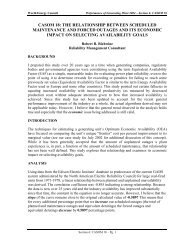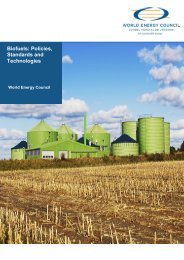Bioethanol – status report on bioethanol production from wood and ...
Bioethanol – status report on bioethanol production from wood and ...
Bioethanol – status report on bioethanol production from wood and ...
You also want an ePaper? Increase the reach of your titles
YUMPU automatically turns print PDFs into web optimized ePapers that Google loves.
• HCL Technologies out of Israel are implementing<br />
a c<strong>on</strong>centrated hydrochloric acid hydrolysis of<br />
<strong>wood</strong>y biomass. The focus is <strong>on</strong> cost reducti<strong>on</strong><br />
<strong>and</strong> technology improvement. The pilot plant will<br />
be built at the Southern Research Institute in North<br />
Carolina.<br />
• TMO Renewables, Guildford, UK - The UK's first<br />
cellulosic ethanol dem<strong>on</strong>strati<strong>on</strong> facility has been<br />
built using biochemical c<strong>on</strong>versi<strong>on</strong> which<br />
incorporates their unique thermophilic bacterium<br />
for fermentati<strong>on</strong> at 60-70ºC. Feedstocks that can<br />
be processed include agricultural waste, <strong>wood</strong><br />
chips, paper <strong>and</strong> municipal waste.<br />
Japan, Australasia, Asia<br />
• BioEthanol Japan - The BioEthanol Japan plant in<br />
Osaka Prefecture has capacity of 1.4 ML/yr <strong>and</strong><br />
had plans to boost producti<strong>on</strong> to 4 ML/yr in 2008.<br />
Wood c<strong>on</strong>structi<strong>on</strong> waste is used as feedstock <strong>and</strong><br />
technology <strong>from</strong> Verenium.<br />
• COFCO/Sinopec <strong>and</strong> Novozymes are collaborating<br />
to build a dem<strong>on</strong>strati<strong>on</strong> cellulosic ethanol plant in<br />
Zhaod<strong>on</strong>g, Heil<strong>on</strong>gjiang province. The feedstock<br />
will be corn stover <strong>and</strong> corn cobs.<br />
• H<strong>on</strong>da-RITE, Japan - collaborati<strong>on</strong> between<br />
H<strong>on</strong>da <strong>and</strong> RITE (Research Institute of Innovative<br />
Technology for the Earth) aims to initially develop<br />
laboratory scale producti<strong>on</strong> of cellulosic ethanol<br />
using biochemical process, with scale up to pilot<br />
plant size envisaged.<br />
• Marubeni, Saraburi, Thail<strong>and</strong> <str<strong>on</strong>g>–</str<strong>on</strong>g> A 3 ML/yr<br />
cellulosic ethanol plant was opened in late 2008<br />
co-located with a sugarcane-ethanol plant<br />
(Marubeni <strong>and</strong> Tsukishima Kikai Co Ltd). The<br />
sugarcane bagasse will be the primary feedstock<br />
<strong>and</strong> Verenium’s process technology will be used.<br />
• China Resources Alcohol Corporati<strong>on</strong>, China -<br />
CRAC is the sec<strong>on</strong>d largest ethanol producer in<br />
China <strong>and</strong> has been operating a cellulosic ethanol<br />
pilot plant in ZhaoD<strong>on</strong>g City, since 2006. Corn<br />
stover feedstock is processed using SunOpta’s<br />
modified steam explosi<strong>on</strong> technology followed by<br />
enzymatic hydrolysis. CRAC's goal was to install<br />
6 ML/yr of cellulosic ethanol capacity by the end<br />
of 2007 <strong>and</strong> 1,250 ML/yr by 2012, the most<br />
ambitious target in the world.<br />
• Missi<strong>on</strong> NewEnergy, India <str<strong>on</strong>g>–</str<strong>on</strong>g> A pilot plant of 0.07<br />
ML/yr cellulosic ethanol utilises agricultural waste<br />
(wheat/rice/corn/barley straw, <strong>and</strong> in the future<br />
Jatropha Curcas, an oil-seed tree) using a novel<br />
hydrolysis process. Lignin is separated <strong>from</strong> the<br />
cellulose <strong>and</strong> hemicellulose prior to hydrolysis,<br />
which is c<strong>on</strong>ducted without the use of any<br />
enzymes. Yields of 500 L/t of feedstock are<br />
<str<strong>on</strong>g>report</str<strong>on</strong>g>ed which is 36% more efficient than<br />
competing cellulosic ethanol technologies. A<br />
commercial scale plant is planned.<br />
• Ethtec, Australia - Ethtec, a Willmott Forests<br />
subsidiary, is currently c<strong>on</strong>structing a pilot plant<br />
for cellulosic ethanol producti<strong>on</strong> at the NSW Sugar<br />
Milling Co-operative Har<strong>wood</strong> Mill <strong>and</strong> Refinery<br />
near Maclean in northern NSW. The plant will use<br />
hydrolysis <strong>and</strong> fermentati<strong>on</strong> technology developed<br />
in collaborati<strong>on</strong> with the University of Southern<br />
Mississippi <strong>and</strong> the University of New South<br />
Wales. The process uses ‘induced phase<br />
separati<strong>on</strong>’ for recovery of ethanol eliminating the<br />
need for c<strong>on</strong>venti<strong>on</strong>al distillati<strong>on</strong>, significantly<br />
improving the energy balance of the process <strong>and</strong><br />
reducing the envir<strong>on</strong>mental impact of the distillery.<br />
It is planned to use <strong>wood</strong> residues (including pine),<br />
bagasse <strong>and</strong> other biomass for the producti<strong>on</strong> of<br />
ethanol.<br />
• Pure Power, Singapore <str<strong>on</strong>g>–</str<strong>on</strong>g> Pure Power has<br />
purchased the NZ-based BioJoule lignocellulosic<br />
c<strong>on</strong>versi<strong>on</strong> technology for the producti<strong>on</strong> of<br />
<strong>bioethanol</strong>, natural lignin <strong>and</strong> xylose. The intended<br />
feedstock is the <strong>wood</strong> crop Salix, a variety of<br />
willow. A unique washing process is used to<br />
preserve <strong>and</strong> recover the lignin which can be used<br />
in paints, glues, resins <strong>and</strong> other phenolic<br />
chemicals which are currently derived <strong>from</strong><br />
petroleum. It is estimated that 80% of the overall<br />
revenue will be derived <strong>from</strong> the lignin <strong>and</strong> xylose<br />
by-products<br />
• LanzaTech, New Zeal<strong>and</strong> <str<strong>on</strong>g>–</str<strong>on</strong>g> This start-up energy<br />
company has dem<strong>on</strong>strated the microbial<br />
c<strong>on</strong>versi<strong>on</strong> of carb<strong>on</strong> m<strong>on</strong>oxide into ethanol. The<br />
company envisages that the process can be<br />
retrofitted to any industrial facility to generate<br />
ethanol <strong>from</strong> the carb<strong>on</strong> m<strong>on</strong>oxide comp<strong>on</strong>ent of<br />
high volume waste flue gases. Scaling-up of the<br />
technology is planned.<br />
• Sci<strong>on</strong>, Rotorua, New Zeal<strong>and</strong> <str<strong>on</strong>g>–</str<strong>on</strong>g> The<br />
Lignocellulosic <str<strong>on</strong>g>Bioethanol</str<strong>on</strong>g> Initiative is a<br />
collaborati<strong>on</strong> between Sci<strong>on</strong>, Verenium, Carter<br />
Holt Harvey, BP <strong>and</strong> Beca AMEC that is<br />
developing a biochemical route using soft<strong>wood</strong>s<br />
for ethanol producti<strong>on</strong>. A pilot plant is being<br />
developed.<br />
SUMMARY<br />
Substantial investment is occurring in c<strong>on</strong>versi<strong>on</strong><br />
technologies <strong>and</strong> in determining the most ec<strong>on</strong>omic,<br />
practical <strong>and</strong> cleanest technology for the producti<strong>on</strong> of<br />
cellulosic ethanol. Pilot plants have successfully<br />
dem<strong>on</strong>strated the producti<strong>on</strong> of ethanol <strong>from</strong><br />
feedstocks, such as agricultural waste, but the<br />
c<strong>on</strong>versi<strong>on</strong> of <strong>wood</strong> waste, particularly soft<strong>wood</strong>s,<br />
c<strong>on</strong>tinues to be more challenging.<br />
It is likely there will be no single preferred c<strong>on</strong>versi<strong>on</strong><br />
technologies for the producti<strong>on</strong> of cellulosic ethanol,<br />
but rather technologies appropriate for specific<br />
feedstocks. For example, the high ash c<strong>on</strong>tent of many

















